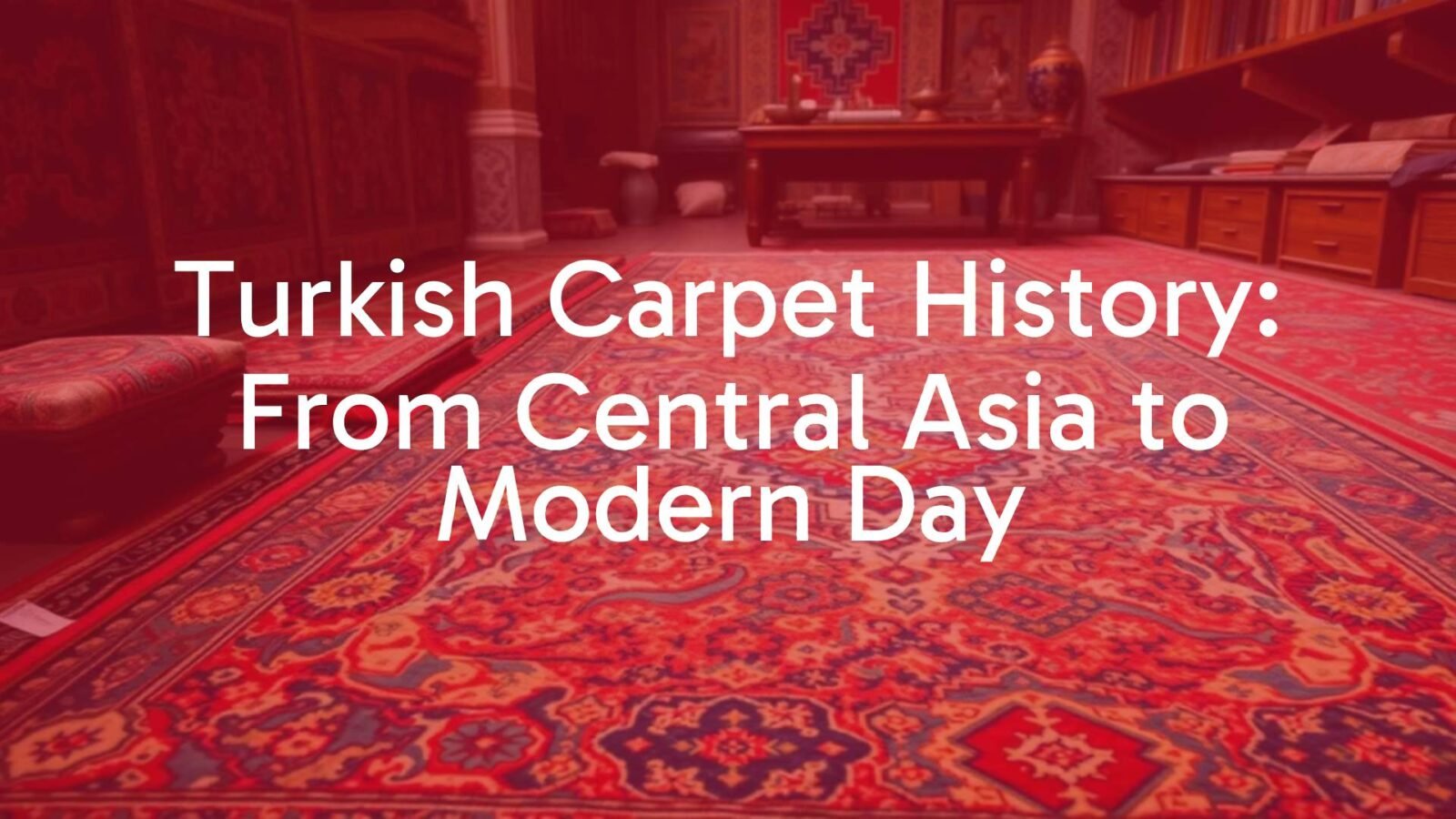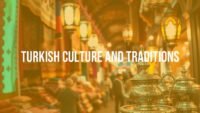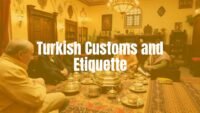Turkish carpets have a long and colorful history that goes back hundreds of years, closely connected to the lives and traditions of the Turkic people. These carpets are more than just floor coverings-they tell stories, showing the skill and culture of the people who made them. The journey of Turkish carpets starts in Central Asia, continues across Anatolia (modern-day Turkey), and has created a reputation for beauty and quality that the world still admires today.
Carpets in Turkey started as practical items for nomads. But over time, they became symbols of wealth and were even given as diplomatic gifts. The look and use of Turkish carpets changed as different empires rose and fell, as cultures mixed, and as people found new ways to create something both useful and beautiful. Every color, knot, and symbol tells a piece of this rich history.
The Beginnings of Turkish Carpets
Central Asian Origins and Tribal Influence
The story of Turkish carpets starts in the tough, cold lands of Central Asia, where nomadic people needed warm, durable things for their homes. Carpets and rugs became very important-they laid them out on tent floors for comfort and warmth. At first, these carpets were made for everyday needs, but the makers still cared about how they looked and added patterns that meant something to their tribe.
The oldest known hand-woven rug is the “Pazirik Rug” from the 3rd century B.C. This rug, likely made by the Huns in Central Asia, shows an advanced level of skill with its very high knot count-36,000 knots in just 10 square centimeters. Even back then, the patterns were often geometric and had special meanings, reflecting what was important in the lives and beliefs of the nomads.

Coming to Anatolia: Big Changes
Anatolia (now Turkey) became a new home for these tribes. By the 11th century, Turkic people were living there. When the Seljuk Empire weakened and Mongol threats grew, more Turkmens came and joined the existing communities. They brought their carpet-making traditions with them, mixing their old ways with new influences from the lands they settled, leading to what we now recognize as the Turkish carpet style.
This mixture of skills and ideas from different places led to a special kind of carpet known as the “Anatolian rug,” the foundation for the carpets made in Turkey today.
Main Time Periods in Turkish Carpet History
Seljuk Period and the Oldest Surviving Carpets
Turkish carpet tradition as we know it took shape in the 13th century, during the Seljuk Empire. After taking over parts of Anatolia around 1071 AD, the Seljuks supported and organized large-scale carpet making. The oldest carpets we still have, found in Konya, Beysehir, and Fostat, date from 1243. They were often as long as 6 meters, showing they were made in larger workshops rather than just in people’s homes. The main jobs for these carpets were to keep buildings warm-mosques, schools, and palaces-and to decorate them. Their designs were simple, repeating shapes like hexagons and stars, with calm colors from natural dyes. The Seljuk time set the basic standards for Turkish carpet making.
Beyliks Period and Changes in Style
After the Seljuks lost power in the 14th century, smaller regions called Beyliks formed. This change meant carpet-making moved from big factories back to more personal production-often in homes or tents. These rugs became smaller, sometimes just the size for praying. They began to show more animals and spiritual symbols like dragons and deer, going back to older shamanistic meanings. Some famous examples are the “rooster rug” and the “Marby Rug.” This period was great for creativity, with weavers expressing more of their ideas and traditions in each rug.
Ottoman Empire: Growth of Carpet Workshops
With the Ottoman Empire taking control in the late 13th and early 14th centuries, Turkish carpet production expanded greatly. By the 15th century, key towns in western Anatolia like Ushak, Gördes, Kula, and others were producing carpets, often under government control. The Ottomans saw carpets as valuable both at home and for trade, even giving them as gifts to other countries. Imperial workshops began making complicated designs, using ideas from tile work and bookbinding. These new, well-organized workshops helped make Turkish carpets famous around the world.
| Time Period | Main Features | Carpet Type/Style |
|---|---|---|
| Seljuk (13th c.) | Large size, geometric repeats, used for warmth | Seljuk carpets |
| Beyliks (14th-15th c.) | Small, animal motifs, return to tribal designs | Principal Period Rugs |
| Ottoman (15th-19th c.) | Large workshops, floral and medallion patterns | Ushak, Hereke, “palace” carpets |
Animal Carpets and Early Patterns
Animal carpets became popular and were even painted by European artists between the 14th and 16th centuries. These displayed creatures like dragons and phoenixes, mixing local and imported ideas. One major motif-the “Dragon and Phoenix”-was introduced by the Mongols from China and quickly became part of Turkish design. These smaller carpets reflected close ties to nomadic and shamanistic beliefs.
Holbein and Lotto Carpets in European Paintings
Turkish carpets made it into many European Renaissance paintings, where they were shown in the homes of wealthy people. Some styles, like the “Holbein” and “Lotto” carpets, are even named after artists who painted them. Holbein rugs have geometric and octagonal patterns. Lotto rugs are known for their lattice designs with stars and medallions. These carpets show just how much Europeans admired Turkish weaves.

Ushak Carpets and the Rise of Major Workshop Rugs
Ushak (Oushak) in western Turkey became a main carpet center during the Ottoman period. By the late 1400s, Ushak rugs were famous for their medallion patterns and high-quality, shiny wool. Their designs were often symmetrical and repeated, with colors like gold and blue. These carpets were highly valued in both Turkey and Europe, still sought after by collectors today.
White Ground and “Transylvanian” Carpets
Some Ottoman Turkish rugs stood out with their white or cream backgrounds, decorated with large medallions and colorful flowers. “Transylvanian” rugs, saved in Romanian churches during the 17th and 18th centuries, often had prayer niche designs. Their survival in European churches shows how highly these carpets were prized across borders.
Ottoman Cairo Carpets and Luxury Weaving
After the Ottomans conquered Egypt in 1517, the skilled carpet makers in Cairo started producing rugs for the Ottoman court. They used different knots and originally made Persian-influenced designs, but eventually adopted Ottoman patterns featuring flowers like tulips and carnations. Made with silk, and sometimes gold and silver threads, these “palace” carpets were luxurious and crafted for the elite.
19th Century: Mecidi Style and Hereke Workshops
In the 1800s, the Ottoman Empire tried to modernize, and this affected carpet making. Workshops like Hereke near Istanbul started using machine-spun yarns and chemical dyes. Hereke became known for making silk carpets with very fine details, often inspired by French designs. Patterns showed lots of flowers and bright colors. Hereke remains famous for producing some of the finest carpets ever made.
Modern Era: Challenge and Revival
The early 20th century brought big changes as the Ottoman Empire ended and the Republic of Turkey began in 1923. Many old workshops closed or broke into smaller businesses. Factories tried to keep the tradition alive, especially at Hereke, but changes in demand and materials made it tough. Today, many Turkish carpets are machine-made, but there are also movements to keep traditional hand-knotting and dyeing alive. These efforts celebrate the unique textures and history of Turkish rugs, passing these skills to new generations.
Types of Turkish Carpets by Maker
- Nomadic Carpets: First made out of need by tribes on the move. These are small, easy to carry, with bold shapes and symbols linked to daily life.
- Village Carpets: Once people settled, carpets got bigger and more detailed. Villages like Ushak and Kula made their own styles, often for sale or trade.
- Town and Court Carpets: Big towns and royal courts, especially during the Ottoman period, had special workshops. Here, weavers used the best materials-sometimes silk and even gold thread-to create luxurious carpets for palaces and mosques.
Weaving Methods and Materials
Wool, Cotton, and Silk
- Wool: Most Turkish carpets use wool, which is strong, shiny, and dyes well. Wool is warm and has always been easy for nomads and villagers to get from their sheep.
- Cotton: Used as the base (warp and weft) in many carpets for extra strength. Cotton helps carpets keep their shape over time.
- Silk: Reserved for the most expensive carpets, especially from Hereke. Silk allows very fine patterns and feels soft and shiny. Some silk carpets even include metallic threads.
Natural Dye Colors
Traditional Turkish carpets get their colors from nature. Reds come from madder root, blues from indigo, and yellows from plants like weld. Sometimes insects provided rich, dark reds. Dyes were fixed with special salts so the color would not wash away. Natural dyes fade softly, giving old carpets a unique look. Chemical dyes, used mainly after the 1870s, offered brighter colors but don’t age the same way.

Knots and Weaving Techniques
- Ghiordes (Turkish) Knot: The main knot in Turkish pile carpets. It makes a strong pile by looping yarn around two warp threads, perfect for durability.
- Kilim/Flatweave: Woven without a pile, by interlocking the threads. Kilims are lightweight and show bold patterns.
- Soumak and Cicim: Special flatweave techniques that add extra design and texture, often with embroidery.
Some court carpets, especially in Cairo, used the Persian (asymmetrical) knot, but the Turkish symmetrical knot is more common and much loved for strength.
Patterns and Symbols in Turkish Carpets
Designs from Central Asia
- Early carpets showed repeating geometric shapes like hexagons and squares.
- Cloud bands (from China) and lotus flowers were borrowed through Silk Road trade and given a Turkish twist.
Islamic and Ottoman Styles
- Prayer niches (mihrab) are a key feature, especially on rugs made for praying. These look like an arch or doorway in the design.
- Kufic-style writing (an old Arabic script) is often found in borders.
- Infinite repeat patterns suggest the never-ending nature of the universe or God.
- During the Ottoman period, naturalistic flower patterns (tulip, carnation, pomegranate) became very popular.
Important Symbols
- Ram’s Horn: Sign of strength, leadership, and was often given as a wedding blessing.
- Tree of Life: Stands for eternal life and hope; common in religious carpets.
- Eight-Pointed Star: A symbol for spiritual light and balance.
- Cross Pattern: Used to protect against the evil eye, a traditional belief in Turkish culture.

Main Carpet Regions and Local Styles
| Region | Famous Centers | Main Features |
|---|---|---|
| Western Anatolia | Ushak, Bergama | Soft, luminous wool, medallion and floral motifs, harmonious colors |
| Central Anatolia | Konya, Sivas, Kayseri | Strong tribal patterns, earthy reds, some made of silk (Kayseri) |
| Eastern Anatolia | Kars, Erzurum | Bold geometric designs, rustic colors, shows tribal heritage |
- Ushak: Known for large medallion designs and soft, high-quality wool. Colors are gentle, like saffron and blue. Very famous in Europe in the past.
- Bergama: Rugs are bold, with bright reds and tribal patterns, reflecting nomadic roots.
- Konya: Site of the oldest Seljuk carpets. Rich in geometric tribal designs and famous for red shades.
- Sivas and Kayseri: Finer patterns, sometimes influenced by Persian designs (especially Kayseri silk rugs).
- Kars and Erzurum: Eastern carpets feature clear, powerful patterns and are more rustic, showing the pastoral lifestyle of their makers.
Common Questions About Turkish Carpets
How do you recognize a real Turkish carpet?
- Look at the back: Hand-knotted Turkish carpets have visible, uneven knots. The back won’t look machine-perfect.
- Material: Authentic Turkish carpets use wool, cotton, or silk. Real wool should be soft and shiny, not rough or plastic-like.
- Color: Older, real carpets use natural dyes. Look for gentle color changes (abrash) within one color-this means it’s handmade with natural dyes.
- Design: Designs are detailed, often with carpets from each region having their own style. Small mistakes and a bit of unevenness usually mean it was handmade.
- Source: Buy from dealers who specialize in Turkish or antique carpets, not from cheap tourist shops.
What makes an old Turkish rug valuable?
- Age and rarity: Older, rare carpets-especially from the Seljuk or early Ottoman periods-are more valuable, especially if well cared for.
- Condition: Rugs with little wear, complete edges, and original ends are worth more. Heavy repairs or missing parts reduce value.
- Materials and dyes: Better wool or silk and true natural dyes make a carpet more valuable.
- Knot density: More knots usually means finer quality.
- Design and artistry: Unusual or especially beautiful designs attract higher prices.
- Provenance: Rugs with known history, especially from famous collections, are more desirable.
- Market trends: Some styles are more in demand, but taste changes over time.
Each Turkish carpet is special, shaped by the place, the hands, and the times in which it was made. Their lasting appeal comes from both their beauty and their deep connection to history and culture.














Leave a comment